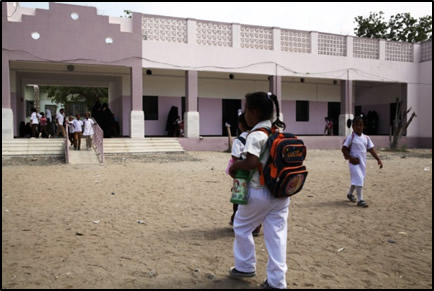Yemen schools rebuilt to welcome back students
By Creative Associates InternationalDecember 3, 2013

During the 2011 political crisis in Yemen, militants seized control of the southern governorate of Abyan. Many of them set up camps in schools, particularly in the capital, Zingibar.
More than 200,000 residents fled to nearby governorates as clashes between Islamic militants and security forces, government airstrikes, banditry and illegal checkpoints made Abyan a no man’s land.
In mid-2012, the new transitional government launched a new military action and, after a month, took back control of Abyan. The fighting left many schools badly damaged and littered with unexploded bombs left behind by retreating militants.
USAID, through the Community Livelihoods Project (CLP), was the first donor to help rehabilitate schools in Abyan as part of its effort to increase access to education in crisis and conflict environments as well as to address the local causes of instability in some of Yemen’s most difficult areas. Working in partnership with the Yemeni government, CLP made the schools safe again for students.
The engineers who supervised the schools’ rehabilitation recalled that the work was an obstacle course, especially when it started in August 2012.
“The Yemen Mine Action Committee had to be on standby not only before we started the construction work, but even a month after, just to help us deal with all the landmines in the schools,” said Ahmed Al-Tashi, senior engineer for the project.
As the new school year opened in mid-September 2013 with schools in better condition than they were before the damage, the corridors are bustling with the energy of happy and excited students and teachers.
Mohamed Omar, deputy headmaster of the Hail Saeed School, another renovated school in Abyan, explained why the school community was in good spirits: “Even before it was damaged during the fighting, our school was generally in very bad condition. After it was rehabilitated, the school is actually now more suitable to learning.”
To date, 15 schools have been renovated and work on three more is nearly completed. More than 10,000 children in the southern governorate are back in class.
Many community members credit the post-conflict school rehabilitation as key to convincing people to return home.
“I believe the reason why most of Abyan’s internally displaced persons came back is because USAID started rebuilding the schools,” says Omar Hadi, manager of the rehabilitated Al-Methaq School. “That was the sign the people needed that things were going back to normal.”
Not long after the construction work started, a nearby restaurant opened for business. It was followed by hardware shops, a water tank shop and a cement factory. Buses soon started plying the old routes. By early 2013, nearly 90 percent of internally displaced persons had returned home to Abyan, and one by one, the renovated schools started welcoming back their old students.
